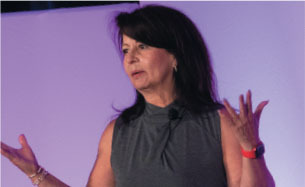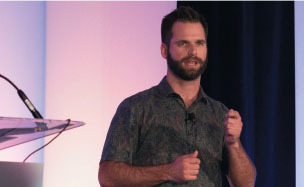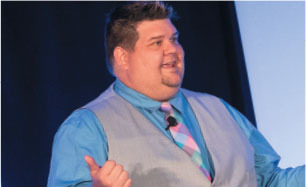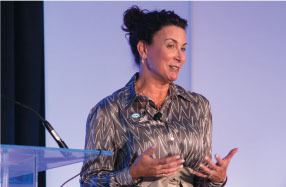How TSAE Developed a Pecha Kucha Keynote
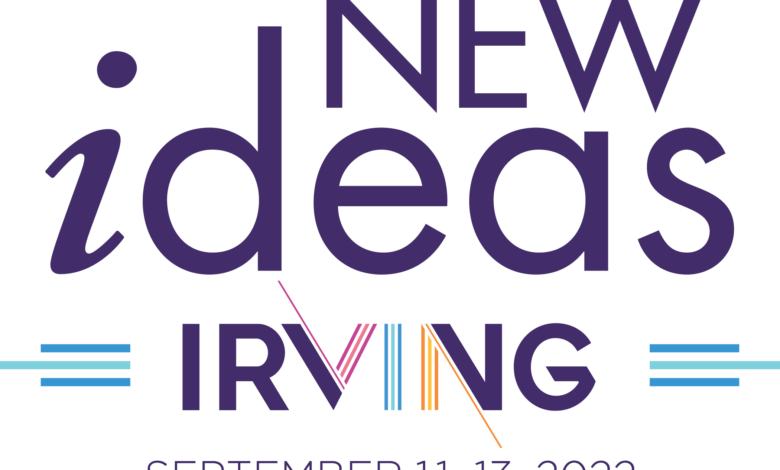
That was eight years ago. Now, she was on stage, in front of 400 of her peers and colleagues sharing her career journey and recognizing the fellowship she received from fellow members as she grew in her leadership role for the TTLA.
McGee, like the three other New Ideas Opening Session speakers, shared their personal experiences on a variety of subjects for a Pecha Kucha-style presentation. Pecha Kucha 20×20 presentation format is a slide show of 20 images, each auto-advancing after 20 seconds. It is non-stop and was created in Japan in 2003 by renowned architects, Astrid Klein and Mark Dytham. The word “Pecha Kucha” is Japanese for “chit chat.”
“In creating the Pecha Kucha session, the task force wanted to ensure we offered a home for member voices and stories to be shared. We also were looking for a way to break out of the traditional keynote speaker mold and show members alternatives to how keynote sessions can be presented at their own events,” said Task Force Chair Lacy Compton. “Adult learning has changed post-pandemic, and we’re finding that members respond to shorter, more authentic content. It felt natural to play with new ways of presenting professional learning like Pecha Kucha at TSAE New Ideas, and I think it was a success!”
The Opening Session featured Philip Prasek, Assistant Director, Client Relationships with Freeman; Kent Prickett, CAE, MB, Executive Director at Infinity Management for Professional Associations & Societies; Gloria Aguilera Terry, CEO at Texas Council on Family Violence; and Tiffany McGee, CAE, CEO at Texas Trial Lawyers.
Each speaker’s topic was unique, personal, and dared to reach the audience in a way that created more vulnerability and community among attendees. Prasek shared a story of overcoming a health scare and finding gratitude and balance in reprioritizing his life to include practical steps to self-care.
“Sharing my story in hopes to motivate the audience towards a healthy relationship with self-care,” said Prasek. “It was a great experience – what an amazing group of people to be associated with!”
Prickett shared his story of resilience as he faced tremendous success at work, but equally devastating twists and turns in his personal life. Terry concluded the series with a reflection on family violence and its effects on all Texans and also a way to steward hope for them.
“We all have personal struggles and wanted to bring tips to the table that attendees could take back to their jobs and implement easily and quickly,” said Prickett.
Taking a risk for an opening session like this took the commitment of a subcommittee from the New Ideas Task Force to develop a process for the selection and execution of the session. From concept, dissemination of the proposal, submission process, selection and then preparation, the whole process took about four months.
The subcommittee began by carving out messaging for soliciting proposals. They then identified suggested topics, outlined the format and support that would be provided to the speakers, if selected.
The committee identified the following topics:
- Stewarding Diversity, Equity, and Inclusion
- Engaging Next Gen
- Planning for What’s Next
- Developing an Innovative Organizational Structure
- Doing More with Less
- Identifying and Implementing Efficiencies
- Creating Collaborative Teams
- Being a Nimble and Financially Responsible Organization
- Leadership, Self-Care, or Motivation Topics
While ideal topics were outlined, the committee did not want to box anyone into an area if they had a compelling story to share. The message also included an option encouraging submissions of a topic outside of those listed.
With a short timeline, they chose to identify and approach the most engaged members. These were members working on committees and participating as volunteers as well as long-tenured members and those who are frequent attendees of TSAE events.
While the process of identifying the pool of possible speakers was rich, asking members to present a personal story on a stage at TSAE’s biggest event was not the easiest ask. Committee and board members encouraged their colleagues to present for the session.
Potential speakers submitted a form with a general idea of their session. The questionnaire asked for descriptions and responses to the following questions:
- Session Idea/Session Title
- 2-3 Sentences That Summarize the Session
- One Key Takeaway of the Session
- Why is this session/information important for association professionals?
- Why are you the ideal person to share this information?
After speakers were selected, TSAE staff stewarded the process of preparing speakers for the opening session by sharing a previously developed timeline, Pecha Kucha resources and samples of sessions.
Speakers then worked with a speaker coach to identify the message of their session and also to improve the delivery of the content to the audience. Speaker Coach Andy Craig applauded the steps TSAE took to develop the session.
“It’s easy for organizations and executives to get stuck in the communication ruts of jargon and densely populated slides. Pecha Kucha is like a software update for presenters. It’s a forcing function that helps them refocus on the fundamentals of effective human communication: storytelling with clear language and supported by simple images,” said Craig. “I’m confident the conference audience will remember those Pecha Kucha presentations for some time. And I’m equally confident the Pecha Kucha speakers will remember that experience for the rest of their careers.”
TSAE encouraged a group effort in the process, scheduling speaker coaching session with all members of the opening session troop. In true Better Together style, TSAE wanted the speakers to support one another and feel like they were a part of something together.
“For me, I made three new friends – it’s was a great way to encourage members to step out of their comfort zone and to build new relationships,” said Prickett.
Speakers encountered challenges with the format, which is an active and highly visible element in the process. Having slides automatically advance made most nervous. They felt the pressure of aligning their message with the image that was featured on screen.
“I would say the challenge was definitely timing the speech just right each time to ensure you could keep pace with the slides,” said Prasek. “Normally you are able to feed off the audience a little and allow extra time here or there for laughs or pauses. This format is a bit more restrictive but provides a nice framework for short messages to really hit home for an audience.”
The session was a risky move for any organization, but TSAE wanted to feature the stories of members – wanted to bring something different and more personal to the start of the conference. This approach may not work with all groups, but it gave the desired effect for which TSAE was looking. Other organizations may choose to establish more concrete guidelines and content topics for it to be most beneficial for their members.
“We loved hearing from Tracy, Kent, Phil, and Gloria, and on behalf of our task force, we are so thankful they stepped up and offered to be brave and vulnerable in sharing their stories with their peers,” said Compton. “We’d love to hear from members who choose to try out a similar presentation style for their keynote sessions – share with us how it worked and how your members responded!”

